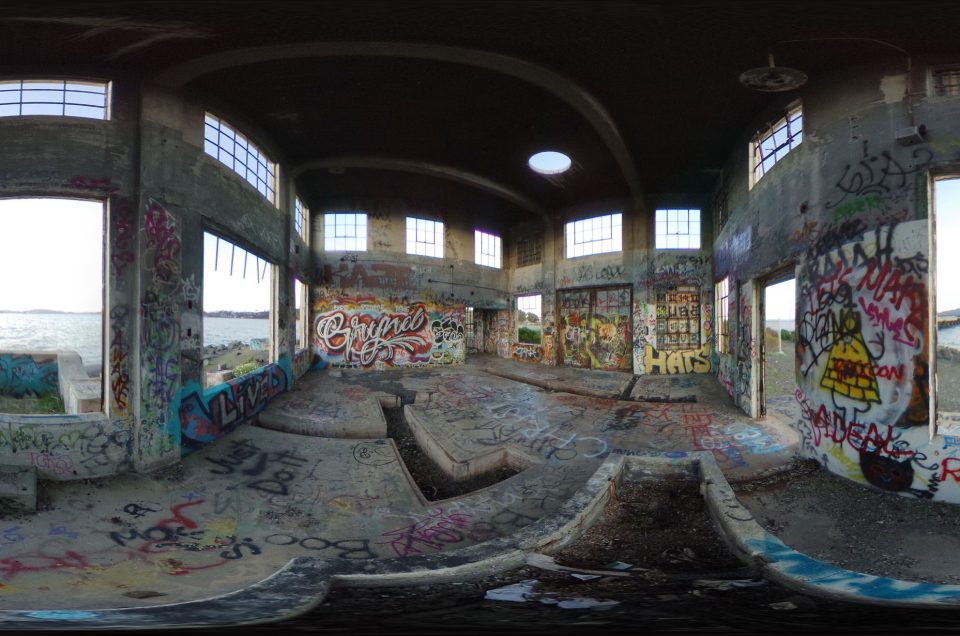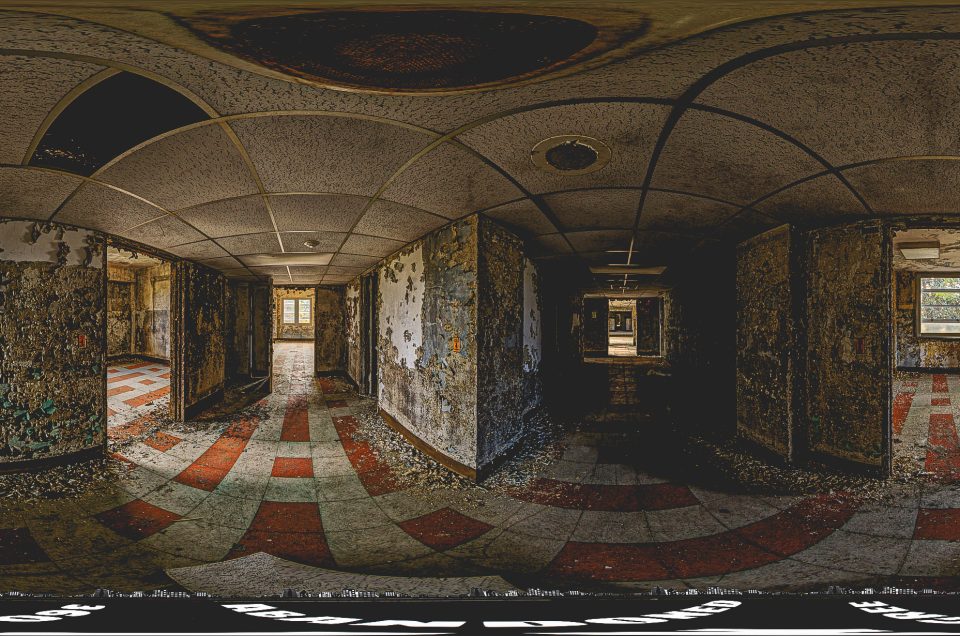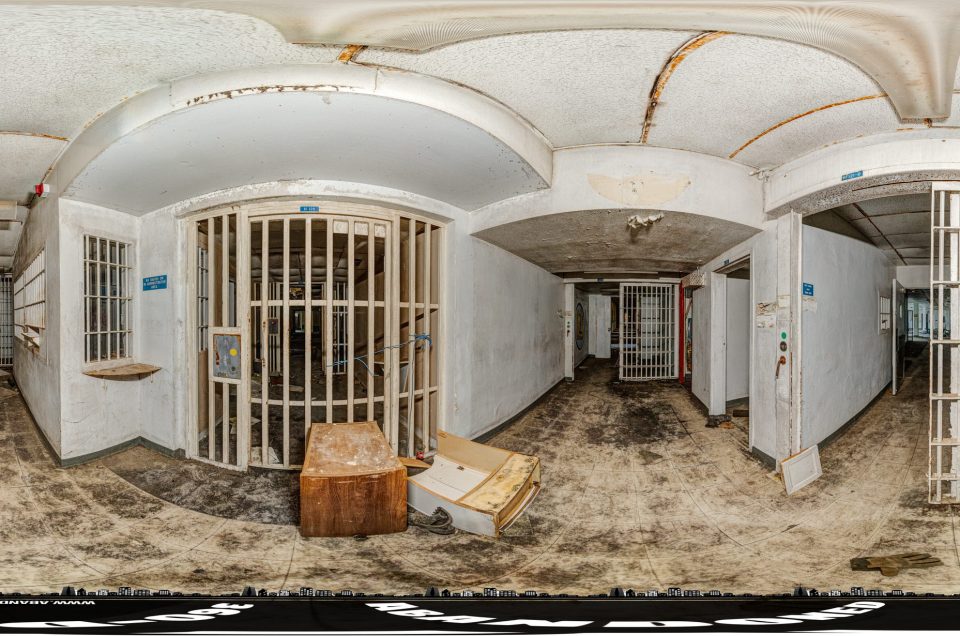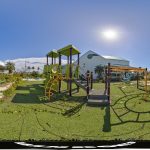From Roadside Stopover to Storm-Damaged Relic: Exploring the Abandoned Super 8 by Wyndham Asheville-Biltmore
Explore the Super 8 by Wyndham Asheville-Biltmore in Asheville, North Carolina, through an immersive digital experience designed for curious urban explorers. This once-bustling roadside motel now sits quiet, its faded signage, peeling paint, and empty corridors hinting at countless stories left behind by travelers passing through the Blue Ridge Mountains.
Take a look at the Super 8 by Wyndham Asheville-Biltmore with an amazing 360-degree virtual tour featuring 15 detailed panoramic images that let you move through the property at your own pace. From the weathered exterior to the abandoned guest rooms and common areas, each scene offers a closer look at the subtle textures of decay and the unique atmosphere that makes locations like this so captivating to the URBEX community.
Click here to view it in fullscreen.
A Flooded Gateway to the Mountains
For years, the Super 8 by Wyndham Asheville-Biltmore was exactly what you’d expect from a budget motel on the edge of the Blue Ridge: pull up, park at your door, crash for the night, and roll out to explore Biltmore, the Blue Ridge Parkway, or downtown Asheville in the morning.
Today, that familiar East Asheville stop has a very different energy. After Hurricane Helene slammed western North Carolina in late September 2024—bringing record-breaking rain, catastrophic flooding, and widespread damage across Asheville and its mountain communities—the little roadside motel on Tunnel Road took a major hit.
Recent traveler reports and aggregated reviews now describe the Super 8 by Wyndham Asheville-Biltmore as closed, with many rooms heavily damaged by the storm and a fence thrown up around the property while legal and insurance issues churn in the background. To urban explorers, that combination—storm damage, abrupt closure, and lingering uncertainty—reads like the early chapter of a modern roadside ruin: abandoned in North Carolina, even if the paperwork still calls it “temporarily closed.”
This guide digs into the motel’s history, its years as a no-frills basecamp for mountain adventures, the storms (literal and metaphorical) that helped put it on life support, and how it fits into the broader world of urban exploring in North Carolina and URBEX culture.
Tunnel Road and the Birth of a Roadside Motel (1980s–1990s)
Why Tunnel Road Matters
Tunnel Road has long been one of East Asheville’s classic approach corridors—a strip of gas stations, chain restaurants, and motels hugging the interstate where travelers slide off I-40, refuel, and decide whether they’re staying the night or pushing deeper into the mountains.
Property records show that the building onTunnel Road—the future Super 8 by Wyndham Asheville-Biltmore—was constructed in 1989 as a one-story hotel/motel complex on a 4.22-acre lot, explicitly classified as a Hotel / Motel structure.
From the start, the building followed the classic late-20th-century budget-motel pattern:
-
Single story with exterior corridors
-
Long rows of identical rooms facing a central parking lot
-
A compact lobby/office block near the entrance
-
A seasonal outdoor pool and small terrace for guests
By the early 1990s and 2000s, travel guides and tourism listings already mention Motel 6 Asheville at this exact address, confirming that the site quickly entered the budget-lodging ecosystem that served Biltmore visitors, Parkway road-trippers, and commercial drivers.
For URBEX fans looking back, this early era is mostly about context: a late-’80s concrete-and-siding roadside motel, built to be practical rather than pretty. What matters is that its layout and bones—the rooms, the pool, the parking lot—set the stage for everything that comes later.
Life as Motel 6: The Long Budget Era
For decades, Motel 6 Asheville anchored this patch of Tunnel Road. Listings in hotel directories and travel guides point to 1415 Tunnel Road as a classic no-frills Motel 6: outdoor pool, basic rooms, pet-friendly policies, and a reputation as one of the cheapest places you could crash within easy driving distance of Biltmore and Warren Wilson College.
As with many long-running budget motels, the property’s life story isn’t glamorous:
-
Extended-stay guests used it as a semi-permanent base while they looked for housing or rode out rough patches in life.
-
Road-trippers and workers passed through for a single night, drawn by the price and easy highway access.
-
Pet owners appreciated the chain’s pet-friendly policies and ground-floor exterior doors that let dogs hop straight into the grass.
This era also brought incidents that, in hindsight, foreshadow the motel’s rougher edges.
A Police Standoff on Tunnel Road
One of the most striking episodes comes from September 2015, when local news reported that Asheville Police evacuated the Motel 6 at 1415 Tunnel Road after a man barricaded himself in a room while officers attempted to serve warrants.
The standoff ended with the suspect taken into custody, but the story illustrates how vulnerable roadside motels can be to drama: open doors, high guest turnover, and the motel’s role as emergency housing can attract everything from minor chaos to headline-worthy incidents.
For urban explorers, this kind of background adds layers: the structure you’re looking at isn’t just a generic box with peeling paint. It’s a place where road-weary families crashed for the night, long-term residents tried to get back on their feet, and police once cleared hallways in the dark before breaching a single low-budget room.
2019: A New Owner and the Super 8 Conversion
The Sale and Rebrand
Fast-forward to 2019, and the Tunnel Road property changed hands. Public real-estate records show that G6 Hospitality Property LLC (the parent company behind Motel 6) sold 1415 Tunnel Road to Balaji Hotel Inc. for roughly $2.15 million in January of that year.
By that point, online travel listings, brand sites, and social pages begin referencing a Super 8 franchise at the address, rebranded as Super 8 by Wyndham Asheville-Biltmore. A Facebook page for “Super 8 Asheville Biltmore East” cites operation starting in early January 2019, aligning with the sale.
The branding shift did several things:
-
Brought the hotel into the Wyndham family of budget properties
-
Updated marketing language around proximity to downtown Asheville, Biltmore Estate, and the Blue Ridge Parkway
-
Refreshed rooms with new bedding, flat-screen TVs, and some cosmetic upgrades
A Typical Super 8 Mountain Basecamp
The Super 8 by Wyndham Asheville-Biltmore quickly slotted into its role as a budget base for mountain adventures. Chain and booking sites highlight:
-
Pet-friendly rooms
-
Complimentary breakfast (often described as pastries, coffee, and juice, rather than a full hot spread)
-
Free Wi-Fi and parking
-
Outdoor pool and sun terrace
-
A short drive to WNC Nature Center, Biltmore Estate, and the Blue Ridge Parkway entrance
At this point, reviews were mixed but not catastrophic—some guests praised the friendly staff and quiet, wooded setting, while others complained about lingering smoke smells, cleanliness issues, and maintenance concerns like flexing floors and noisy neighbors.
From a URBEX perspective, this is the “before” snapshot: a functioning roadside motel with aging infrastructure, patched-up rooms, and a constant flow of travelers. Nothing about it screamed “future ruin” yet, but the cracks were already forming.
Cracks in the Armor: Complaints, Bugs, and Everyday Scandals
Budget motels often live on the edge—financially, physically, and socially. The Super 8 by Wyndham Asheville-Biltmore was no exception.
Bed Bugs, Roaches, and Reputation
A 2023 review on a hotel guide site bluntly reported both roaches and bed bugs in a room at the property, a harsh hit for any budget motel’s already fragile reputation.
Elsewhere, guests complained about:
-
Poor housekeeping and dirty linens
-
Non-smoking rooms that smelled heavily of cigarettes or weed
-
Weak structural feel to the floors in some rooms
-
The sense that long-term residents and short-term guests were being mixed without clear management strategy
None of this is unique for a low-cost highway motel, but every review like this nudged the Super 8 further into the “sketchy but survivable” category—a place people would still book if the rate was right and the location was convenient, but rarely their first choice.
Extended Stay Tension
Comments from local hospitality workers and guests describe a pattern familiar across many budget properties in the region: guests staying long enough to flirt with residency rules, frequent moves between motels to avoid tenant protections, and friction when management tried to enforce turnover or reclaim rooms.
For urban explorers who care about the social context of abandonment, this matters. When a property finally tips into closure, the stories of the people who lived inside those rooms for months or years linger in the air even after the last mattress is dragged out.
Hurricane Helene: The Storm That Changed Everything
A Historic, Catastrophic Flood
In late September 2024, Hurricane Helene tore across the Southeast as one of the costliest and deadliest storms in North Carolina’s history.
For Asheville, the impact was brutal:
-
Record rainfall, with nearly 10 inches reported over two days
-
The French Broad and Swannanoa rivers exceeding historic flood levels from 1916
-
Road and bridge failures that briefly isolated the city
-
Long-lasting infrastructure damage, including to the regional water system
Helene isn’t just a plot point—it’s the backdrop that turns a tired budget motel into a storm-scarred relic.
How Helene Hit the Super 8 by Wyndham Asheville-Biltmore
By early 2025, aggregated Google reviews and travel-planning sites began to show a very different status for the Super 8 by Wyndham Asheville-Biltmore:
-
Wanderlog summarises the property as “Temporarily Closed”.
-
A April 2025 Google review (quoted in summary form on Wanderlog) states that the motel was no longer open, that many rooms were destroyed by Hurricane Helene, and that a fence had been erected around the property while guests struggled to recover belongings or refunds.
Other still-active listing sites continued to advertise the Super 8, sometimes without acknowledging the closure, but the on-the-ground reports point toward a property that had essentially shut down after storm damage and not yet returned to normal operations.
When you layer that over the wider picture of Asheville’s post-Helene hotel scene—historic properties downtown temporarily closed or partially gutted, flood-damaged infrastructure, and a tourism industry trying to claw back from disaster—the idea of a small, low-margin roadside motel staying dark for an extended period becomes very believable.
From a URBEX standpoint, this is the pivot: a storm-battered roadside motel, fenced off, with interior damage and unresolved claims. Functionally open one year, effectively abandoned in North Carolina the next.
Reading the Ruin: Layout, Atmosphere, and Storytelling Potential
Even in its operating days, the Super 8 by Wyndham Asheville-Biltmore had a layout that begged to be photographed: low wings under mature trees, doors facing the parking rows, and the mountains rising behind the rooftops. Booking-site photos show long one-story buildings wrapping around a central lot, with simple railings and concrete walkways tying everything together.
Viewed through a URBEX lens, that configuration sets up some classic compositional opportunities if you ever encounter a similar property that’s legally accessible:
-
Receding corridor lines – Doors and window frames forming converging lines along the walkway.
-
Pool reflections – If the pool survives as a stagnant basin rather than being filled in, reflections of railings, trees, and signage can make eerie compositions.
-
Signage vs. decay – The bright yellow and red Super 8 logo (often mounted near the road) contrasted with broken windows or overgrown landscaping can tell a whole story in one frame.
Right now, online reports indicate heavy damage and a perimeter fence rather than a fully open, walk-through ruin. That means actually going inside would almost certainly mean trespassing and potentially crossing into an active insurance or legal situation—exactly the kind of context where responsible urban explorers should keep their distance.
But understanding the layout and history still adds a lot of depth to any exterior or street-view documentation you may capture legally from public vantage points.
Where It Fits in the URBEX Landscape of North Carolina
North Carolina is full of photogenic decay: textile mills, furniture factories, forgotten schools, derelict motels along I-40 and I-85, and half-collapsed tourist attractions from different booms and busts. For anyone into urban exploring in North Carolina, the Super 8 by Wyndham Asheville-Biltmore checks several interesting boxes:
-
Roadside Americana
It’s a direct descendant of the great American road-trip tradition—cheap motels lining the highways as gateways to national parks, mountain towns, and tourist estates like Biltmore. -
Storm-Damaged Infrastructure
Unlike many abandoned sites that died slow economic deaths, this one appears to have been pushed over the edge by a specific, historically significant event: Hurricane Helene and its record flooding. -
Social and Ethical Layers
The long-term residents, complaints about lost belongings after the storm, and the fence raised around the property while guests fought for refunds all hint at a stressful, human story running alongside the physical decay.
For URBEX storytellers, that mix—roadside architecture, extreme weather, and messy human fallout—makes the Super 8 a perfect case study in how modern disasters reshape the built environment.
Ethics, Legality, and Safety: A Reality Check
Before we dive deeper into exploring tips and photographic ideas, it’s important to be absolutely clear:
Nothing in this guide is encouragement to trespass, break laws, or ignore safety barriers.
The Super 8 by Wyndham Asheville-Biltmore:
-
Has been described as fenced off after Helene.
-
Suffered significant storm damage to its rooms.
-
Sits in a heavily traveled corridor where law enforcement and local residents are very much present.
That makes it a high-risk site to approach beyond public right-of-way. If you’re serious about responsible URBEX:
-
Respect fences and “No Trespassing” signs.
-
Treat damaged structures as potentially unstable—even a one-story motel can hide rotten framing, undermined foundations, or sudden floor failures after flooding.
-
Remember that storm-damaged properties often involve ongoing insurance, lawsuits, and investigations. Wandering inside isn’t just dangerous; it can interfere with very real, very current legal processes.
If you want to involve this site in your work, focus on:
-
Documenting from public vantage points
-
Using official historical data to tell its story
-
Pairing it with your own legally accessible abandoned sites to illustrate broader patterns of post-disaster decay
URBEX Gear Checklist for Abandoned Motels
Whether you’re exploring an old Super 8, a defunct roadside inn, or a forgotten motor court, the basic URBEX kit is similar. Use this checklist when you’re heading to legally accessible abandoned properties—public tours, permission-granted locations, or sites open to visitors.
Core gear
-
Headlamp + backup flashlight – Exterior-corridor motels may have dark bathrooms or interior storage rooms even in daylight.
-
Extra batteries – Because every interesting door seems to lead to a darker space.
-
Sturdy footwear – Think boots or trail shoes; roadside motels often have broken glass, nails, and slick pool decks.
-
Gloves – For moving debris or steadying yourself on rough surfaces.
Camera setup
-
Wide-angle lens – Perfect for long corridors of doors, narrow bathrooms, and whole-room shots.
-
Tripod – Helpful for low-light interiors or exterior twilight scenes when you’re documenting from the street.
-
Polarizing filter – Cuts reflections on motel windows and standing water.
Safety extras
-
N95 or P100 mask/respirator – Flood-damaged buildings can harbor mold and dust.
-
Basic first-aid kit – Cuts and scrapes happen fast in broken environments.
-
Weather-appropriate clothing – Western North Carolina can go from sunny to stormy quickly, especially around the mountains.
Again: only use this kit where you have legal access. The goal is to explore, not to rack up charges or injuries.
Telling the Story: From Construction to Abandonment
To build a strong URBEX narrative about the Super 8 by Wyndham Asheville-Biltmore, it helps to lay out the key dates:
-
1989 – Construction of the motel building at 1415 Tunnel Road as a one-story hotel/motel.
-
1990s–2010s – Operates as Motel 6 Asheville, appearing in travel guides and tourism publications as a basic, pet-friendly roadside option with an outdoor pool.
-
2015 – Police evacuate the motel during a standoff, underlining the property’s role in more than just tourism.
-
January 2019 – Property sold from G6 Hospitality (Motel 6) to Balaji Hotel Inc.; rebrand to Super 8 by Wyndham Asheville-Biltmore with updated marketing and modest room renovations.
-
2019–2023 – Operates as a budget Super 8 with mixed reviews, including praise for the location and staff but criticism for cleanliness and pests.
-
Late September 2024 – Hurricane Helene batters western North Carolina with historic flooding, damaging hotels, roads, and utilities across Asheville.
-
Late 2024–April 2025 – Online review sources report that the Super 8 is closed, with many rooms destroyed by Helene, guest belongings reportedly discarded or inaccessible, and a fence erected around the property.
From a pure data standpoint, some listings still treat it like a bookable hotel. But from a boots-on-the-ground and URBEX perspective, the combination of storm damage, fenced perimeters, and long-term closure paints a convincing picture of a motel drifting into modern abandonment in North Carolina.
Urban Exploring in North Carolina After Helene
The story of this Super 8 ties into a bigger pattern: how Hurricane Helene reshaped the URBEX landscape across western North Carolina.
-
Flood-damaged factories, warehouses, and small motels now dot Asheville, Swannanoa, Lake Lure, and other mountain towns, joining older waves of industrial ruins left by the decline of textile and furniture manufacturing.
-
Some historic hotels and tourist properties closed for months to gut and rebuild interiors; others may never fully reopen.
For explorers, this means:
-
More recent decay – Fresh water damage, mud lines on walls, and flood-warped structures rather than century-old brick slowly crumbling.
-
More complicated ethics – Unlike long-abandoned factories, post-Helene sites often involve ongoing insurance claims, FEMA work, and recent trauma for local residents.
It’s crucial to approach these places with empathy. When you’re documenting a storm-damaged motel like the Super 8 by Wyndham Asheville-Biltmore—even from the street—you’re not just photographing an empty building. You’re capturing one tiny part of a regional disaster that took lives, destroyed homes, and permanently changed communities.
Tips for Responsible URBEX Around the Super 8 and Similar Sites
To keep your urban exploring in North Carolina both ethical and sustainable, especially around disaster-affected properties:
-
Stick to public vantage points unless you clearly have permission.
Sidewalks, public roads, and other open areas often give plenty of angles to document storm-damaged properties. -
Avoid interacting with interiors of recently closed businesses.
If a structure was still operating within the last couple of years and especially if it closed due to a major event like Helene, treat it as off-limits unless invited. -
Be invisible to the business of recovery.
Don’t interfere with crews, inspectors, or owners. If you see active repair or cleanup, step back—those people need space to work. -
Mind the community.
Western North Carolina is still processing the long tail of Helene’s damage. Locals may not appreciate seeing their disaster zones turned into backdrops, especially if you’re posing rather than quietly documenting. -
Tell full stories, not just ruin porn.
When you share work that includes the Super 8 by Wyndham Asheville-Biltmore or other Helene-damaged spots, fold in context about the storm, regional impacts, and the human side of the disaster.
Conclusion: A Modern Relic on Tunnel Road
The Super 8 by Wyndham Asheville-Biltmore isn’t a haunted Victorian asylum or a crumbling industrial giant. It’s something more subtle and more modern: a low-slung roadside motel built in 1989, rebranded and refreshed in 2019, battered by one of the most destructive storms in North Carolina history in 2024, and left in a limbo of fences, damage, and unanswered questions.
For urban explorers, it shows how quickly an everyday place can slide from budget stopover to storm-scarred relic. One year you’re checking in with your dog and a cooler full of snacks; the next, you’re driving past a fenced property where the lights are permanently off and the sign slowly fades in the mountain sun.
If you’re building an URBEX portfolio focused on sites abandoned in North Carolina, the Super 8’s story belongs in your research. Just remember:
-
Respect the fence and the legal reality on the ground.
-
Use your camera and notebook from public space.
-
Let the combination of roadside architecture, storm history, and human drama fuel your storytelling—without crossing the line into trespass.
In the end, the Super 8 by Wyndham Asheville-Biltmore is a reminder that URBEX isn’t just about forgotten places from a distant past. Sometimes, it’s about watching in real time as a very ordinary building becomes an unintended monument to weather, economics, and the fragile lives that pass through a cheap motel room off the interstate.
If you liked this blog post, you might be interested in learning about Camp Beechwood in New York, the Mombello Psychiatric Hospital in Italy, or the Knoxville College campus in Tennessee.
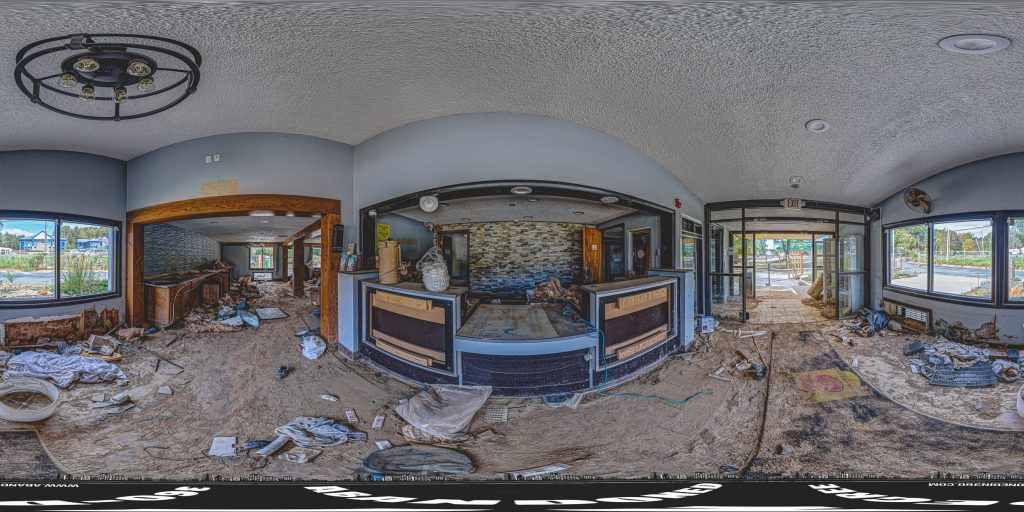
A 360-degree panoramic image inside the abandoned Super 8 by Wyndham Asheville-Biltmore. Photo by the Abandoned in 360 URBEX Team.
Welcome to a world of exploration and intrigue at Abandoned in 360, where adventure awaits with our exclusive membership options. Dive into the mysteries of forgotten places with our Gold Membership, offering access to GPS coordinates to thousands of abandoned locations worldwide. For those seeking a deeper immersion, our Platinum Membership goes beyond the map, providing members with exclusive photos and captivating 3D virtual walkthroughs of these remarkable sites. Discover hidden histories and untold stories as we continually expand our map with new locations each month. Embark on your journey today and uncover the secrets of the past like never before. Join us and start exploring with Abandoned in 360.
Equipment used to capture the 360-degree panoramic images:
- Canon DSLR camera
- Canon 8-15mm fisheye
- Manfrotto tripod
- Custom rotating tripod head
Do you have 360-degree panoramic images captured in an abandoned location? Send your images to Abandonedin360@gmail.com. If you choose to go out and do some urban exploring in your town, here are some safety tips before you head out on your Urbex adventure. If you want to start shooting 360-degree panoramic images, you might want to look onto one-click 360-degree action cameras.
Click on a state below and explore the top abandoned places for urban exploring in that state.
